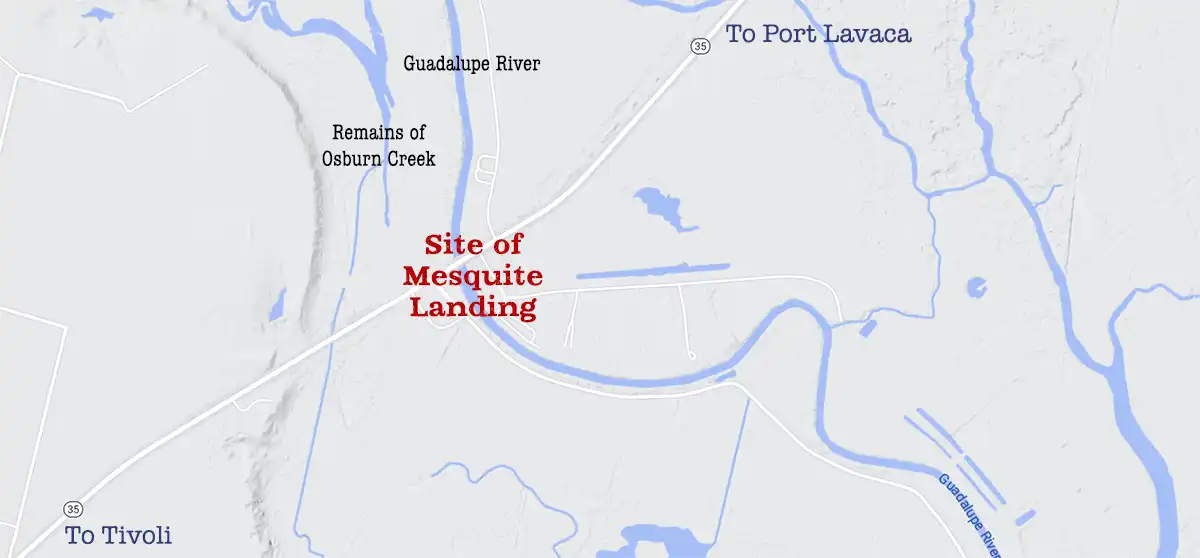
Locating the Site of Mesquite Landing
Various historic documents or relics mention that Mesquite Landing (or Rancho de los Mosquitos) was located at or below the confluence of the Guadalupe and San Antonio Rivers. Pinpointing the actual location was a challenge. The E.S. Winsor survey of 1881 was a great description of the Landing relative to Osburn Creek and the San Antonio (actually, Guadalupe) River. Because of changes in the creek, now a marshy area, it was difficult to pinpoint where the old wharf might actually have been. However, the faint handwriting of the original survey documents (dated 5 December 1850) for George C. Hatch‘s headright and the GLO Energy Business GIS Map Viewer with original abstract layers overlayed provided the answer. The Hatch survey notes: “640 acres in Refugio County on the San Antonio River 3 miles below the junction of the Guadalupe. Beginning at the Pierce Rollins corner near Mesquite Landing on the San Antonio River on the S.E. bank of Osburn’s Creek at a prickly ash …” Plotted on a current day map, it’s precisely where Texas Hwy 35 crosses the Guadalupe River north east of Tivoli.
Padre/Captain José Antonio Valdez
ca. 1787 Mexico – 1846 Mexico
Valdez was a very colorful and controversial character. What makes him germane to the story of Mesquite Landing is that, in 1824 (well before establishment of the Power and Hewetson Colony), Valdez was granted four leagues of land in the “V” between the San Antonio and Guadalupe Rivers, precisely at their confluence. He established quite a large rancho there at Mesquite Landing. As early as 1793, old settlers in the area had reported foundations of buildings and remains of stockades on both sides of the rivers which were deemed to be the remains of barns or corrals belonging to the Refugio Mission or the Valdez rancho.
Valdez was a chaplain in the Spanish army with the rank of captain, and history mentions him as both Padre Valdez and Captain Valdez. He served at San Fernando de Béxar and also at La Báhia. In 1834, a portion of the Valdez rancho was granted to Maria Josefa Travieso (noted to be a widow) and her son, José Maria Valdez. Young José was reputed to be the son of Captain Valdez. During the Revolution in Texas, Padre Valdez was taken as a Mexican prisoner in Goliad and charged with improper communications with the enemy (showing them where to build a bridge over the San Antonio River). Documents describe him as “an old priest … a miserable, meagre, squalid looking creature, who is said to be a very immoral character, and yet a man of considerable property.” He still owned the rancho at Mesquite Landing.
In 1840, Padre Valdez was removed from his roles in the Catholic Church, due to dereliction of duty and public concubinage. He left Texas and settled in Mexico where he died.
William Kuykendall
Ca. 1810 Territory of Missouri – 1862 Texas
Kuykendall was one of the Old Three Hundred settlers of Texas, arriving about 1821 with his family. They settled near present day Brenham. While in his teens, young Kuykendall accompanied his father and brothers in patrolling the Old San Antonio Road during the Fredonian Rebellion. He received a grant for a quarter league of land on Mill Creek in what is now Austin County. He married Eliza Caruthers and they had nine children. Kuykendall also participated in the siege of Béxar, for which he received a 640 acre Donation Grant. From 1836-1838, he provided horses and corn to the Army of the Republic of Texas — and served as a ranger under Col. Edward Burleson. Additionally, he served in the Republic of Texas Army in its campaign against Ráfael Vásquez in 1842. In the late 1840s, he settled his family near Mesquite Landing. In 1852, Kuykendall found a Karankawa campsite on the shores of Hynes Bay. He was in the group of settlers who attacked the camp and forced survivors of the attack to leave Texas.
Middleton vs. McGrew
December 1859. Reuben Middleton vs. Dr. William Patrick Henry McGrew.
Reuben wanted land at the confluence (owned by Dr. McGrew) based on the fact that he was an heir of the original grantee, Joshua Davis. Unfortunately, it was decided against Middleton based on the laws in 1835 that an alien heir of a colonist of Texas/Mexico who died intestate could not inherit. Joshua Davis’s relatives were not legal citizens nor did they meet the criteria to be legal citizens of Texas/Mexico at the time of Davis’s death. Dr. McGrew kept his land and ferry.
O’Connor vs. Gullett
Content being developed for this section.
